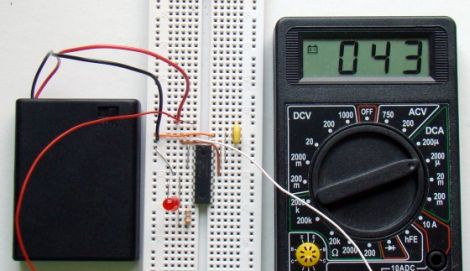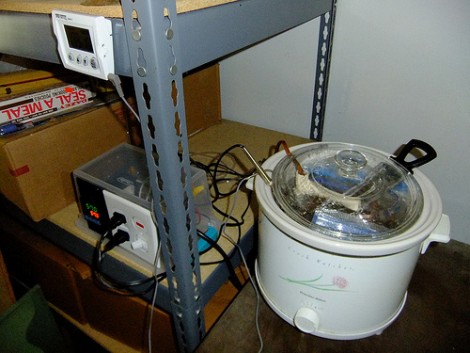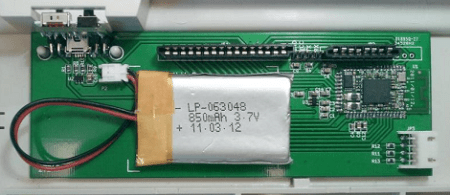For decades a thunderous roar rose from the bowels of IBM keyboards like the animus of angry and forgotten gods. These keyboards have fallen silent of late, due only to incompatibility with newer hardware. Now, Model Ms have been given a reprieve from landfills or recycling centers because of the work of [wulax] of geekhack and his Model M Bluetooth controller board.
Month: August 2011
Stretch Your Circuit’s Battery Life By Putting Your PIC To Sleep

[Rajendra Bhatt] wrote in to share the latest in a series of PIC tutorials, which covers the microcontroller’s Sleep mode – a very useful tool for limiting current consumption in battery-powered applications.
He discusses how to put the PIC in sleep mode, as well as some common mistakes to watch out for, such as accidentally allowing I/O pins to sink or source current while sleeping. [Rajendra] also walks through the various ways a PIC can be brought out of sleep mode, focusing the majority of his tutorial to the mcu’s watchdog timer.
Using a PIC16F628A, he constructs a test circuit which allows him to demonstrate the power savings gained by using sleep mode rather than the microcontroller’s built-in delay function. The circuit simply blinks an LED every 4.3 seconds, using the watchdog timer for the first 2.3 seconds, and a delay() call for the rest of the time.
The power savings are quite substantial, similar to the results we saw using AVR microcontrollers a few weeks ago. [Rajendra] found that using the sleep function limited current consumption to about 4.5% of the current used when calling the mcu’s delay function – a huge savings.
Quit Monkeying About!
This friendly little monkey is the latest creation from [Jan Sieber] and [Ralph Kistler]. Yes it’s another Kinect Hack, the Kinect tracks the users stance using the OpenNI Framework and OSCeleton. The information is sent to an Arduino crammed inside the monkey, also inside the poor little monkey are 10 servo motors and a nightmarish wire skeleton. The monkey is left dangling from the Kinect sensor by several cables, ready to follow your every move. The monkey seems fairly sprightly for someone who has had all their insides removed, it is able to copy a multitude of stances quite swiftly.
The video after the break shows the monkey in action for about 1 minute. Then the team go through the build and application of the clever little monkey in a musical/documentary style video. There is also a creepy section where the monkey draws its own skeleton then freaks out.. Enjoy..
Hacking QR Codes For Fun And Profit
QR codes are everywhere these days, from being printed onto receipts to chiseled into granite tombstones. [Will] came up with a way to modify existing QR codes, and his hack has the potential to cause quite a bit of harmless mischief.
[Will]’s hack involves a little photo editing, transparency film, and some white-out/Liquid Paper/Tippex. After the ‘target’ and ‘destination’ QR codes have been imported into Gimp, the differences are found and the result printed out on a transparency sheet. After that, hang the transparency over the original and the QR code now goes to the URL of your choice.
Gain Wizardly Knowledge About Crystals

Make sure your test equipment is handy, then give this video series about crystal oscillators a spin. [Shahriar] of the Signal Path Blog put together a four-part video blog post totaling about an hour. In the discussion he covers the ins and outs of crystal oscillators and ring oscillators. His focus is on how these parts are used as timekeeping devices for microcontrollers. This isn’t a lecture that skims the surface of the topic, it takes you down the rabbit hole, discussing theory, how the devices are built, how to use them, and the pitfalls of doing so.
Our favorite part is in the fourth segment when [Shahriar] measures the effect that temperature has on crystals by spraying them with an inverted compressed air canister. We always thought we were just screwing around when freezing stuff like that. It didn’t occur to us that we were conducting serious experiments.
We’ve embedded the first segment of the video after the break. Continue reading “Gain Wizardly Knowledge About Crystals”
Ever Wonder Where Cool Interactive Museum Exhibits Come From?

[Victor’s] girlfriend works at a museum and enlisted his expertise in designing an interactive detective game for kids visiting the museum. The vision was for the kids to discover phone numbers that they could call for clues. Originally he planned to display the clues on a character LCD, but obviously it’s much neater to hear the clues in the handset of the phone.
Quickly switching gears, [Victor] dropped the ATtiny2313 and started over with an Xmega chip — in fact, it was our recent Xmega post that inspired him to document his project. The microcontroller is responsible for a lot of goings-on. It scans the key matrix for inputs, simulates the DTMF touch tones, reads audio files from a FAT file system on an SD card, and plays them back over the hand set’s speaker. Since most of the hardware is already built into the phones, it was not hard to fit his add-ons inside the case. A simple audio amplifier circuit joins the microcontroller, which is patched into the rows and columns of the keyboard. Take a gander at the video after the break to see the device in action.
Continue reading “Ever Wonder Where Cool Interactive Museum Exhibits Come From?”
Sous Vide Crock Pot Controller

Tempted by what sous vide cooking has to offer, but balking at the price for a unitasker, [Lee’s] father in law set out to see if he could rig up his own precision temperature controlled cooking system on the cheap. He immediately hit eBay and shelled out about around $75 to get his hands on a solid state relay, PID controller, and temperature probe.
As you can see above, a crock pot serves as the cooking vessel. We’ve seen this method before, either splicing into the power cord, or providing a single outlet on the controller. This version provides a PID controlled outlet to which the appliance can be plugged in. The other outlet in the socket is always on and powers an aquarium pump that circulates the heated water during the cooking process.
The result works quite well, even though it wasn’t a huge cost savings. There are a few issues with positioning of the temperature probe, but that may be where experience comes into play.













